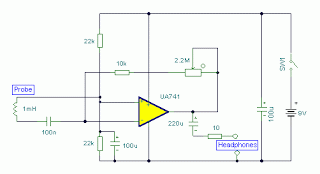
Lie detector

The two probes are held in the hands, and the skin resistance applies bias to the transistor. The 5 k ohm potentiometer is adjusted for zero deflection on the meter. When the subject experiences embarrassment or deception, sweating occurs on the hands, which increases the bias to the transistor and disrupts the bridge balance.
The described circuit utilizes a pair of probes that measure skin resistance, which serves as an input to a transistor-based circuit. This configuration is commonly employed in lie detection systems or galvanic skin response (GSR) applications. The two probes are typically made of conductive material and are designed to make contact with the skin, allowing for the measurement of electrical resistance that varies with the moisture level of the skin.
The circuit includes a 5 k ohm potentiometer, which is used to calibrate the system. By adjusting this potentiometer, the operator can set the meter to read zero when the subject is in a neutral state, without any emotional stress. This zero point is crucial for accurate readings, as it establishes a baseline for comparison when the subject's emotional state changes.
When the subject experiences emotions such as embarrassment or deceit, physiological responses occur, leading to increased perspiration. This sweating causes a decrease in skin resistance, which in turn increases the bias applied to the transistor. This change in bias alters the operating point of the transistor, affecting the output signal and causing a deviation from the previously established bridge balance.
The output of the transistor can be connected to a meter or an analog-to-digital converter for further processing. The meter will show deflection from the zero point established by the potentiometer, indicating the level of emotional response. In summary, this circuit effectively utilizes the principles of skin resistance and transistor biasing to provide insights into the emotional state of a subject, making it a valuable tool in various psychological and physiological studies.The two probes shown are held in the hands and the skin resistance applies bias to the transistor. The 5 k ohm pot is set for zero deflection on the meter. When the ' 'subject'' is embarrassed or lies, sweating on the hands takes place, increasing the bias to the transistor and upsetting the bridge balance. Enjoy!
The described circuit utilizes a pair of probes that measure skin resistance, which serves as an input to a transistor-based circuit. This configuration is commonly employed in lie detection systems or galvanic skin response (GSR) applications. The two probes are typically made of conductive material and are designed to make contact with the skin, allowing for the measurement of electrical resistance that varies with the moisture level of the skin.
The circuit includes a 5 k ohm potentiometer, which is used to calibrate the system. By adjusting this potentiometer, the operator can set the meter to read zero when the subject is in a neutral state, without any emotional stress. This zero point is crucial for accurate readings, as it establishes a baseline for comparison when the subject's emotional state changes.
When the subject experiences emotions such as embarrassment or deceit, physiological responses occur, leading to increased perspiration. This sweating causes a decrease in skin resistance, which in turn increases the bias applied to the transistor. This change in bias alters the operating point of the transistor, affecting the output signal and causing a deviation from the previously established bridge balance.
The output of the transistor can be connected to a meter or an analog-to-digital converter for further processing. The meter will show deflection from the zero point established by the potentiometer, indicating the level of emotional response. In summary, this circuit effectively utilizes the principles of skin resistance and transistor biasing to provide insights into the emotional state of a subject, making it a valuable tool in various psychological and physiological studies.The two probes shown are held in the hands and the skin resistance applies bias to the transistor. The 5 k ohm pot is set for zero deflection on the meter. When the ' 'subject'' is embarrassed or lies, sweating on the hands takes place, increasing the bias to the transistor and upsetting the bridge balance. Enjoy!





